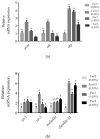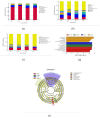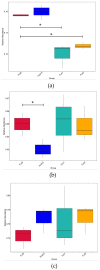Fucoidan Improves Growth, Digestive Tract Maturation, and Gut Microbiota in Large Yellow Croaker (Larimichthys crocea) Larvae
- PMID: 36364770
- PMCID: PMC9654794
- DOI: 10.3390/nu14214504
Fucoidan Improves Growth, Digestive Tract Maturation, and Gut Microbiota in Large Yellow Croaker (Larimichthys crocea) Larvae
Abstract
The early life period is considered an essential period for gut microbial colonization. Manipulating gut microbiota interventions during early life periods has been proven to be a promising method to boost healthy growth. Therefore, the aim of the present study was to investigate the effects of dietary fucoidan (Fuc) on the growth, digestive tract maturation, and gut microbiota of large yellow croaker (Larimichthys crocea) larvae. Four diets were formulated with different levels of Fuc (0.00%, 0.50%, 1.00%, and 2.00%). Results showed that dietary Fuc significantly improved the growth performance of larvae. Meanwhile, dietary Fuc promoted digestive tract maturation. Dietary 1.00% Fuc significantly improved intestinal morphology. Dietary Fuc upregulated the expression of intestinal cell proliferation and differentiation related-genes and intestinal barrier related-genes. Dietary 2.00% Fuc significantly increased the activities of brush border membranes enzymes and lipase while inhibiting α-amylase. Furthermore, dietary Fuc maintained healthy intestinal micro-ecology. In detail, dietary 1.00% and 2.00% Fuc altered the overall structure of the gut microbiota and increased the relative abundance of Bacteroidetes while decreasing the relative abundance of opportunistic pathogens and facultative anaerobe. In conclusion, appropriate dietary Fuc (1.00-2.00%) could improve the growth of large yellow croaker larvae by promoting digestive tract maturation and maintaining an ideal intestinal micro-ecology.
Keywords: digestive tract maturation; early life intervention; fucoidan; gut microbiota; large yellow croaker larvae.
Conflict of interest statement
The authors declare no conflict of interest.
Figures






Similar articles
-
Early Life Intervention Using Probiotic Clostridium butyricum Improves Intestinal Development, Immune Response, and Gut Microbiota in Large Yellow Croaker (Larimichthys crocea) Larvae.Front Immunol. 2021 Mar 8;12:640767. doi: 10.3389/fimmu.2021.640767. eCollection 2021. Front Immunol. 2021. PMID: 33763082 Free PMC article.
-
The effects of kelp powder and fucoidan on the intestinal digestive capacity, immune response, and bacterial community structure composition of large yellow croakers (Larimichthys crocea).Fish Shellfish Immunol. 2024 Oct;153:109810. doi: 10.1016/j.fsi.2024.109810. Epub 2024 Aug 5. Fish Shellfish Immunol. 2024. PMID: 39111606
-
Effects of dietary succinic acid supplementation on growth performance, digestive ability, intestinal development and immunity of large yellow croaker (Larimichthys crocea) larvae.Fish Shellfish Immunol. 2024 Dec;155:109972. doi: 10.1016/j.fsi.2024.109972. Epub 2024 Oct 17. Fish Shellfish Immunol. 2024. PMID: 39423905
-
Ontogeny of the gastrointestinal tract of marine fish larvae.Comp Biochem Physiol C Toxicol Pharmacol. 2001 Dec;130(4):477-87. doi: 10.1016/s1532-0456(01)00274-5. Comp Biochem Physiol C Toxicol Pharmacol. 2001. PMID: 11738635 Review.
-
Tripartite relationship between gut microbiota, intestinal mucus and dietary fibers: towards preventive strategies against enteric infections.FEMS Microbiol Rev. 2021 Mar 16;45(2):fuaa052. doi: 10.1093/femsre/fuaa052. FEMS Microbiol Rev. 2021. PMID: 33026073 Review.
Cited by
-
Effects of supplemental fulvic acid on survival, growth performance, digestive ability and immunity of large yellow croaker (Larimichthys crocea) larvae.Front Physiol. 2023 Mar 23;14:1159320. doi: 10.3389/fphys.2023.1159320. eCollection 2023. Front Physiol. 2023. PMID: 37064905 Free PMC article.
-
Assessment of Nonalcoholic Fatty Liver Disease Symptoms and Gut-Liver Axis Status in Zebrafish after Exposure to Polystyrene Microplastics and Oxytetracycline, Alone and in Combination.Environ Health Perspect. 2023 Apr;131(4):47006. doi: 10.1289/EHP11600. Epub 2023 Apr 7. Environ Health Perspect. 2023. PMID: 37027337 Free PMC article.
-
Mitigation Exposed to Cadmium Stress in Thinlip Grey Mullet (Liza ramada) By Dietary Fucoidan Derived from Sargassum muticum: Examining the Growth Performance, Immune Response, and Histopathological Alterations.Biol Trace Elem Res. 2025 Aug 11. doi: 10.1007/s12011-025-04744-5. Online ahead of print. Biol Trace Elem Res. 2025. PMID: 40790005
References
-
- Dogra S., Sakwinska O., Soh S.-E., Ngom-Bru C., Brück W.M., Berger B., Brüssow H., Lee Y.S., Yap F., Chong Y.-S., et al. Dynamics of Infant Gut Microbiota Are Influenced by Delivery Mode and Gestational Duration and Are Associated with Aubsequent Adiposity. mBio. 2015;6:e02419-14. doi: 10.1128/mBio.02419-14. - DOI - PMC - PubMed
MeSH terms
Substances
LinkOut - more resources
Full Text Sources

